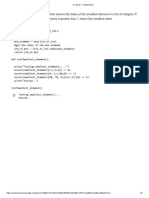07-ProgrammingR - Programming With Data in R
Uploaded by
oussbio0707-ProgrammingR - Programming With Data in R
Uploaded by
oussbio07Programming with data in R
Susan Holmes (c)
Logical statements
Suppose I use the data on births from fivethirtyeight we
looked at in the last session. I would like to extract all
the children born on Friday the 13th.
Download the "births.csv" data from our folder:
https://stanford.box.com/s/jm9pe4c4ve1kuw2kenlxohogo56ogsve
You can place the data directly in your working directory to make it
easier to use. If you are not sure where your current working directory
is, you can always check your directory using command getwd().
load("births.RData")
head(births)
## year month date_of_month day_of_week births
## 1 2000 1 1 6 9083
## 2 2000 1 2 7 8006
## 3 2000 1 3 1 11363
## 4 2000 1 4 2 13032
## 5 2000 1 5 3 12558
## 6 2000 1 6 4 12466
summary(births)
## year month date_of_month day_of_week
## Min. :2000 Min. : 1.000 Min. : 1.00 Min. :1
## 1st Qu.:2003 1st Qu.: 4.000 1st Qu.: 8.00 1st Qu.:2
## Median :2007 Median : 7.000 Median :16.00 Median :4
## Mean :2007 Mean : 6.523 Mean :15.73 Mean :4
## 3rd Qu.:2011 3rd Qu.:10.000 3rd Qu.:23.00 3rd Qu.:6
## Max. :2014 Max. :12.000 Max. :31.00 Max. :7
## births
## Min. : 5728
## 1st Qu.: 8740
## Median :12343
## Mean :11350
## 3rd Qu.:13082
## Max. :16081
I can see that the data on day of the week is not a factor
but a numeric encoding, in fact Friday is encoded as 5.
Fridays=births[which(births[,4]==5),]
Which of the Friday births occurred on the 13th?
Fridays13=Fridays[which(Fridays[,3]==13),]
head(Fridays13)
## year month date_of_month day_of_week births
## 287 2000 10 13 5 11723
## 469 2001 4 13 5 10881
## 560 2001 7 13 5 12187
## 987 2002 9 13 5 13028
## 1078 2002 12 13 5 11600
## 1260 2003 6 13 5 12013
dim(Fridays13)
## [1] 25 5
Weekendbirths=births[which(births[,4]%in%c(6,7)),]
Weekdaybirths=births[which(births[,4]<6),]
Valid ways of generating TRUE or FALSE
Sign Meaning Example
== Equals day_of_week == 5
!= Does not equal year != 0
Sign Meaning Example
> Greater than day_of_week > 5
>= Greater than or equal date_of the week >= 6
< Less than day_of_week <2
<= Less than or equal to day_of_week <=1
%in% Included in births[,4]%in%c(6,7)
is.na() Is a missing value is.na(births[,4])
Conditions and directions
if (condition){
Do something
} else {
Do something different
}
if (mean(Weekendbirths[,5])> mean(Weekdaybirths[,5]))
{ cat("More weekend babies on average") }else {
cat("There are less weekend babies on average")
}
## There are less weekend babies on average
Loops and repeats
One may want to repeat a computation for each
different element of a vector, sometimes we need to do
this with loops and sometimes we avoid this with what is
called vectorization.
A typical loop:
set.seed(431)
mat43=replicate(4,sample(3,3))
mat43l=rep(0,4)
for (j in 1:4)
{mat43l[j]=max(mat43[,j])}
mat43l
## [1] 3 3 3 3
A vectorized version:
apply(mat43,2,max)
## [1] 3 3 3 3
Why is vectorization faster, since the number of
operations seems always the same?
apropos("apply")
## [1] ".mapply" "apply" "dendrapply" "eapply" "kernapply"
## [6] "lapply" "mapply" "rapply" "sapply" "tapply"
## [11] "vapply"
?apply
Because R is interpreted it deals with assigning types and
memory to variables on the fly. The inner representation
of every variable is a vector, it expects to act on vectors
even if only one number is involved.
Actual example with larger numbers:
mat43=replicate(5000,sample(30000,1000))
dim(mat43)
## [1] 1000 5000
system.time(apply(mat43,2,max))
## user system elapsed
## 0.061 0.009 0.070
mat43l=rep(0,5000)
system.time(for (j in 1:5000)
{mat43l[j]=max(mat43[,j])})
## user system elapsed
## 0.041 0.003 0.044
Functions in R
R is called a functional programming language because
the actions we take are done using functions, even
quitting at the end is done using q().
Example
library(readxl)
read_excel
## function (path, sheet = 1, col_names = TRUE, col_types = NULL,
## na = "", skip = 0)
## {
## path <- check_file(path)
## ext <- tolower(tools::file_ext(path))
## switch(excel_format(path), xls = read_xls(path, sheet, col_names,
## col_types, na, skip), xlsx = read_xlsx(path, sheet, col_names,
## col_types, na, skip))
## }
## <environment: namespace:readxl>
Writing our own functions
Useful if you are execute the same set of commands on
different data or with different parameters.
vec=c(1,2,3,5,7,11,13,17,19,23)
(vec^2)+ 1
## [1] 2 5 10 26 50 122 170 290 362 530
(vec^2)+ 3
## [1] 4 7 12 28 52 124 172 292 364 532
(vec^3)
## [1] 1 8 27 125 343 1331 2197 4913 6859 12167
Suppose we wanted to take another vector and see
which of its elements were divisible by 2,3,5, or other
numbers.
We write a function
ExpAnd <- function(vec,exponent,addto)
{
vec^exponent+addto
}
We will put it and edit it in the top part of our RStudio
IDE and save it as a file that we can also source later.
ExpAnd <- function(vec,exponent,addto)
{
out=vec^exponent+addto
return(out)
}
ExpAnd <- function(vec,exponent,addto)
{##Function that takes argument vec to the power
## exp, adds add and then outputs the result
out=vec^exponent+addto
return(out)
}
Question What happens if you apply your function with
vec = 3, exponent=4, and addto=4 ?
Question What happens if you type:
ExpAnd()
Put some default values in the function:
ExpAnd <- function(vec=seq(4,25,3),exponent=2,addto=3)
{
# Function that takes argument vec to the power
# exp, adds add and then outputs the result
out<-vec^exponent+addto
return(out)
}
ExpAnd()
## [1] 19 52 103 172 259 364 487 628
Question: Try calling the function ExpAnd with
ExpAnd(vec=seq(4,25,3),exponent=2,addto="3")
ExpAnd(vec=seq(4,25,3),exponent=2,addto="3")
ExpAnd <- function(vec=seq(4,25,3),exponent=2,addto=3){
# Function that takes argument vec to the power
# exp, adds add and then outputs the result
if (any(!is.numeric(c(vec,exponent,addto))))
stop("One of the arguments is not numeric.")
out <- vec^exponent+addto
return(out)
}
What happens if we now type:
ExpAnd(addto="4")
Functions are quite robust to some changes in the input:
ExpAnd(vec=matrix(c(2,3,4,1,1,2,2,7),ncol=2),3,0)
## [,1] [,2]
## [1,] 8 1
## [2,] 27 8
## [3,] 64 8
## [4,] 1 343
Note: Passing an unspecified number of parameters to a
function
We can pass extra, unspecified arguments to a function
by using the ... notation in the argument list.
add20 <- function(x, ...) {
k <- x+20
return(k)
}
Summary of this Session:
We have introduced the notion of logical
variables that test certain facts.
We saw how to combine the function which
with a logical statement to take a subset of the
data.
We can execute blocks of commands
encapsulated with {} using if and else with
logical conditions.
We saw that functions are an important
component of R programming.
Their basic elements are a name, an argument
and an output that is returned using the return
function.
We edit functions in an external file and can call
them in later session by using the function
source().
We can test the flow of the function and stop it if
something goes awry.
Question: Go to the cheatsheet: Base R
Look at all the functions we have not tried yet and try
the examples.
You might also like
- Hourglass Workout Program by Luisagiuliet 276% (21)Hourglass Workout Program by Luisagiuliet 251 pages
- The Hold Me Tight Workbook - Dr. Sue Johnson100% (16)The Hold Me Tight Workbook - Dr. Sue Johnson187 pages
- Read People Like A Book by Patrick King-Edited62% (66)Read People Like A Book by Patrick King-Edited12 pages
- Livingood, Blake - Livingood Daily Your 21-Day Guide To Experience Real Health77% (13)Livingood, Blake - Livingood Daily Your 21-Day Guide To Experience Real Health260 pages
- COSMIC CONSCIOUSNESS OF HUMANITY - PROBLEMS OF NEW COSMOGONY (V.P.Kaznacheev,. Л. V. Trofimov.)94% (212)COSMIC CONSCIOUSNESS OF HUMANITY - PROBLEMS OF NEW COSMOGONY (V.P.Kaznacheev,. Л. V. Trofimov.)212 pages
- Donald Trump & Jeffrey Epstein Rape Lawsuit and Affidavits83% (1016)Donald Trump & Jeffrey Epstein Rape Lawsuit and Affidavits13 pages
- The 36 Questions That Lead To Love - The New York Times94% (34)The 36 Questions That Lead To Love - The New York Times3 pages
- The 36 Questions That Lead To Love - The New York Times95% (21)The 36 Questions That Lead To Love - The New York Times3 pages
- Jeffrey Epstein39s Little Black Book Unredacted PDF75% (12)Jeffrey Epstein39s Little Black Book Unredacted PDF95 pages
- ISAPI Developer Guide - Entrance & Exit Management - Entrance & Exit Management - 2024!04!02100% (2)ISAPI Developer Guide - Entrance & Exit Management - Entrance & Exit Management - 2024!04!021,567 pages
- The 4 Hour Workweek, Expanded and Updated by Timothy Ferriss - Excerpt23% (954)The 4 Hour Workweek, Expanded and Updated by Timothy Ferriss - Excerpt38 pages
- Solutions Manual Using R Introductory STNo ratings yetSolutions Manual Using R Introductory ST33 pages
- Type KAVR 100, 130: Multi-Shot Auto-Reclose and Check Synchronizing RelayNo ratings yetType KAVR 100, 130: Multi-Shot Auto-Reclose and Check Synchronizing Relay8 pages
- M800-M80-E80 Series Maintenance Manual Ib1501273enghNo ratings yetM800-M80-E80 Series Maintenance Manual Ib1501273engh224 pages
- A La Busqueda Del Sinfonismo Perdido - Perez de Arteaga - Ritmo 453-455 (1975) PDF100% (1)A La Busqueda Del Sinfonismo Perdido - Perez de Arteaga - Ritmo 453-455 (1975) PDF27 pages
- Glocal University: Practical File of R Programming100% (1)Glocal University: Practical File of R Programming32 pages
- Twittermining: 1 Twitter Text Mining - Required LibrariesNo ratings yetTwittermining: 1 Twitter Text Mining - Required Libraries4 pages
- Sample - Mid - Exam - S1 - 24-25.ipynb - ColabNo ratings yetSample - Mid - Exam - S1 - 24-25.ipynb - Colab4 pages
- Problem Set 1: Introduction To R - Solutions With R Output: 1 Install PackagesNo ratings yetProblem Set 1: Introduction To R - Solutions With R Output: 1 Install Packages24 pages
- Lecture 2: More Data Structures: OutlineNo ratings yetLecture 2: More Data Structures: Outline16 pages
- Solution Manual for Using Multivariate Statistics 7th Edition Barbara G. Tabachnick, Linda S. Fidell - Read Online Or Download Now100% (6)Solution Manual for Using Multivariate Statistics 7th Edition Barbara G. Tabachnick, Linda S. Fidell - Read Online Or Download Now35 pages
- Lecture_5_(Managing_and_Understanding_Data)No ratings yetLecture_5_(Managing_and_Understanding_Data)9 pages
- R-Workshop: Training Program On R Programming Basic ConceptsNo ratings yetR-Workshop: Training Program On R Programming Basic Concepts21 pages
- Download full Solution Manual for Using Multivariate Statistics 7th Edition Barbara G. Tabachnick, Linda S. Fidell all chapters100% (20)Download full Solution Manual for Using Multivariate Statistics 7th Edition Barbara G. Tabachnick, Linda S. Fidell all chapters43 pages
- XGB-U +manual V1.0+XBC-DN32UUAUP XBC-DR28UUAUP PDFNo ratings yetXGB-U +manual V1.0+XBC-DN32UUAUP XBC-DR28UUAUP PDF1,322 pages
- 5G PPP 5G Architecture White Paper FinalNo ratings yet5G PPP 5G Architecture White Paper Final182 pages
- Download Oracle Cloud Infrastructure: A Guide to Building Cloud Native Applications Jeevan Gheevarghese Joseph & Adao Oliveira Junior & Mickey Boxell ebook All Chapters PDF100% (5)Download Oracle Cloud Infrastructure: A Guide to Building Cloud Native Applications Jeevan Gheevarghese Joseph & Adao Oliveira Junior & Mickey Boxell ebook All Chapters PDF66 pages
- Guide To Computer Network Security Chapter1No ratings yetGuide To Computer Network Security Chapter116 pages
- 16.5.1 Packet Tracer Secure Network Devices IZtNo ratings yet16.5.1 Packet Tracer Secure Network Devices IZt2 pages
- IBM CC0103EN Certificate Cognitive ClassNo ratings yetIBM CC0103EN Certificate Cognitive Class1 page
- There Is No Such Thing As A Microservice!: Chris RichardsonNo ratings yetThere Is No Such Thing As A Microservice!: Chris Richardson71 pages
- Programming Methodology in C: Hugh AndersonNo ratings yetProgramming Methodology in C: Hugh Anderson117 pages
- Aspect Based Sentiment Analysis Approaches and AlgorithmsNo ratings yetAspect Based Sentiment Analysis Approaches and Algorithms4 pages
- Eastern Coalfields Limited Mining Sirdar Posts NotificationNo ratings yetEastern Coalfields Limited Mining Sirdar Posts Notification5 pages
- Livingood, Blake - Livingood Daily Your 21-Day Guide To Experience Real HealthLivingood, Blake - Livingood Daily Your 21-Day Guide To Experience Real Health
- COSMIC CONSCIOUSNESS OF HUMANITY - PROBLEMS OF NEW COSMOGONY (V.P.Kaznacheev,. Л. V. Trofimov.)COSMIC CONSCIOUSNESS OF HUMANITY - PROBLEMS OF NEW COSMOGONY (V.P.Kaznacheev,. Л. V. Trofimov.)
- Donald Trump & Jeffrey Epstein Rape Lawsuit and AffidavitsDonald Trump & Jeffrey Epstein Rape Lawsuit and Affidavits
- The 36 Questions That Lead To Love - The New York TimesThe 36 Questions That Lead To Love - The New York Times
- The 36 Questions That Lead To Love - The New York TimesThe 36 Questions That Lead To Love - The New York Times
- Jeffrey Epstein39s Little Black Book Unredacted PDFJeffrey Epstein39s Little Black Book Unredacted PDF
- ISAPI Developer Guide - Entrance & Exit Management - Entrance & Exit Management - 2024!04!02ISAPI Developer Guide - Entrance & Exit Management - Entrance & Exit Management - 2024!04!02
- The 4 Hour Workweek, Expanded and Updated by Timothy Ferriss - ExcerptThe 4 Hour Workweek, Expanded and Updated by Timothy Ferriss - Excerpt
- Type KAVR 100, 130: Multi-Shot Auto-Reclose and Check Synchronizing RelayType KAVR 100, 130: Multi-Shot Auto-Reclose and Check Synchronizing Relay
- M800-M80-E80 Series Maintenance Manual Ib1501273enghM800-M80-E80 Series Maintenance Manual Ib1501273engh
- A La Busqueda Del Sinfonismo Perdido - Perez de Arteaga - Ritmo 453-455 (1975) PDFA La Busqueda Del Sinfonismo Perdido - Perez de Arteaga - Ritmo 453-455 (1975) PDF
- Glocal University: Practical File of R ProgrammingGlocal University: Practical File of R Programming
- Twittermining: 1 Twitter Text Mining - Required LibrariesTwittermining: 1 Twitter Text Mining - Required Libraries
- Problem Set 1: Introduction To R - Solutions With R Output: 1 Install PackagesProblem Set 1: Introduction To R - Solutions With R Output: 1 Install Packages
- Solution Manual for Using Multivariate Statistics 7th Edition Barbara G. Tabachnick, Linda S. Fidell - Read Online Or Download NowSolution Manual for Using Multivariate Statistics 7th Edition Barbara G. Tabachnick, Linda S. Fidell - Read Online Or Download Now
- R-Workshop: Training Program On R Programming Basic ConceptsR-Workshop: Training Program On R Programming Basic Concepts
- Download full Solution Manual for Using Multivariate Statistics 7th Edition Barbara G. Tabachnick, Linda S. Fidell all chaptersDownload full Solution Manual for Using Multivariate Statistics 7th Edition Barbara G. Tabachnick, Linda S. Fidell all chapters
- XGB-U +manual V1.0+XBC-DN32UUAUP XBC-DR28UUAUP PDFXGB-U +manual V1.0+XBC-DN32UUAUP XBC-DR28UUAUP PDF
- Download Oracle Cloud Infrastructure: A Guide to Building Cloud Native Applications Jeevan Gheevarghese Joseph & Adao Oliveira Junior & Mickey Boxell ebook All Chapters PDFDownload Oracle Cloud Infrastructure: A Guide to Building Cloud Native Applications Jeevan Gheevarghese Joseph & Adao Oliveira Junior & Mickey Boxell ebook All Chapters PDF
- There Is No Such Thing As A Microservice!: Chris RichardsonThere Is No Such Thing As A Microservice!: Chris Richardson
- Aspect Based Sentiment Analysis Approaches and AlgorithmsAspect Based Sentiment Analysis Approaches and Algorithms
- Eastern Coalfields Limited Mining Sirdar Posts NotificationEastern Coalfields Limited Mining Sirdar Posts Notification























































































































